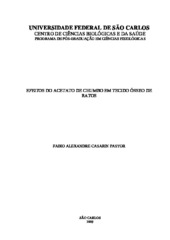| dc.contributor.author | Pastor, Fabio Alexandre Casarin | |
| dc.date.accessioned | 2016-06-02T19:22:51Z | |
| dc.date.available | 2009-07-23 | |
| dc.date.available | 2016-06-02T19:22:51Z | |
| dc.date.issued | 2009-04-09 | |
| dc.identifier.citation | PASTOR, Fabio Alexandre Casarin. Efeitos do acetato de chumbo em tecido ósseo de ratos. 2009. 132 f. Dissertação (Mestrado em Ciências Biológicas) - Universidade Federal de São Carlos, São Carlos, 2009. | por |
| dc.identifier.uri | https://repositorio.ufscar.br/handle/ufscar/1307 | |
| dc.description.abstract | Lead is a ubiquitous pollutant in the environmental ecosystem which distribution is mainly anthropogenic, come from burning fossil fuels, mining and various industrial products. There
is little knowledge of the involvement of this element on the bone metabolism. This study aimed to determine possible changes in adult rat bone, contaminated with lead acetate during the development phase, through the incorporation of lead in the tissue. Biometric, biophysical, and biomechanical bone parameters were analyzed. The animals were divided into 3 groups: control, 9 rats treated with saline 0.9% (0.1 ml/100g BM) and contaminated groups C-100 and C-200 with 10 animals each, poisoned with lead acetate (100 and 200 mg / kg BM, respectively), once per week for 8 weeks by gastric gavage method. The incorporation of lead was examined with scanning electron microscopy and the concentration of this element in bone tissue with atomic absorption spectrometry with flame. We calculated the bone volume, and from this parameter the bone density was determined. The biomechanical properties of femurs were obtained by three points bending test. Contamination with lead acetate promoted incorporation and increased the concentration of lead in bone for the two doses tested,
however were not sufficient to cause changes in the somatic and bone development of these animals. The dose of 100 mg / kg BM was not enough to cause bone changes and the dose of 200 mg / kg BM caused reduced bone density and strength. Therefore, the results indicate the ability of this element in damage the quality of the bone and maybe, serve as a source for endogenous subsequent contamination. | eng |
| dc.description.sponsorship | Universidade Federal de Sao Carlos | |
| dc.format | application/pdf | por |
| dc.language | por | por |
| dc.publisher | Universidade Federal de São Carlos | por |
| dc.rights | Acesso Aberto | por |
| dc.subject | Tecido ósseo | por |
| dc.subject | Acetato de chumbo | por |
| dc.subject | Biomecânica óssea | por |
| dc.subject | Densidade óssea | por |
| dc.subject | Rato | por |
| dc.subject | Bone tissue | eng |
| dc.subject | Lead acetate | eng |
| dc.subject | Bone biomechanics | eng |
| dc.subject | Bone density | eng |
| dc.subject | Rat | eng |
| dc.title | Efeitos do acetato de chumbo em tecido ósseo de ratos | por |
| dc.type | Dissertação | por |
| dc.contributor.advisor1 | Nonaka, Keico Okino | |
| dc.contributor.advisor1Lattes | http://genos.cnpq.br:12010/dwlattes/owa/prc_imp_cv_int?f_cod=K4781719U9 | por |
| dc.description.resumo | Chumbo é um poluente ubíquo no ecossistema cuja distribuição ambiental é principalmente antropogênica, oriunda da queima de combustíveis fósseis, mineração e fabricações
industriais diversas. Há pouco conhecimento do envolvimento deste elemento sobre o metabolismo ósseo. O objetivo deste estudo foi estabelecer possíveis alterações ósseas em ratos adultos, contaminados com acetato de chumbo durante a fase de desenvolvimento, por meio da incorporação de chumbo neste tecido. Foram analisados parâmetros biométricos, biofísicos, e biomecânicos ósseos. Os animais foram divididos em 3 grupos: controle, com 9 ratos tratados com salina 0,9% (0,1 ml/100g MC) e contaminados C-100 e C-200 com 10 animais cada, intoxicados com acetato de chumbo (100 e 200 mg/kg MC, respectivamente), 1 vez por semana, por 8 semanas pelo método de gavagem gástrica. A incorporação de chumbo foi analisada com microscopia eletrônica de varredura e as concentrações deste elemento no
tecido ósseo com espectrometria de absorção atômica com chama. Calculou-se o volume ósseo, e a partir deste parâmetro a densidade óssea foi determinada. As propriedades
biomecânicas dos fêmures foram obtidas pelo teste de flexão a três pontos. A contaminação com acetato de chumbo promoveu incorporação e aumento da concentração de chumbo no tecido ósseo para as duas doses testadas, entretanto não foram suficientes para provocar alterações no desenvolvimento somático e ósseo destes animais. A dose de 100 mg/kg MC não foi suficiente para provocar alterações ósseas e a dose de 200 mg/kg MC provocou redução da densidade e resistência óssea. Portanto, os resultados apontam a capacidade deste elemento em prejudicar a qualidade do tecido ósseo e talvez servir como fonte endógena para contaminações subseqüentes. | por |
| dc.publisher.country | BR | por |
| dc.publisher.initials | UFSCar | por |
| dc.publisher.program | Programa Interinstitucional de Pós-Graduação em Ciências Fisiológicas - PIPGCF | por |
| dc.subject.cnpq | CIENCIAS BIOLOGICAS::FISIOLOGIA | por |
| dc.contributor.authorlattes | http://lattes.cnpq.br/3130130830810690 | por |
